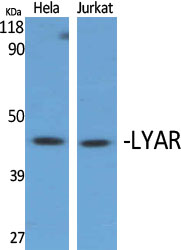LYAR Polyclonal Antibody
- 产品详情
- 实验流程
- 背景知识
Application
| WB, IHC-P, IF, ICC, E |
|---|---|
| Primary Accession | Q9NX58 |
| Reactivity | Human, Rat, Mouse |
| Host | Rabbit |
| Clonality | Polyclonal |
| Calculated MW | 43634 Da |
| Gene ID | 55646 |
|---|---|
| Other Names | LYAR; PNAS-5; Cell growth-regulating nucleolar protein |
| Dilution | WB~~Western Blot: 1/500 - 1/2000. Immunohistochemistry: 1/100 - 1/300. ELISA: 1/10000. Not yet tested in other applications. IHC-P~~1:50~200 IF~~1:50~200 ICC~~N/A E~~N/A |
| Format | Liquid in PBS containing 50% glycerol, 0.5% BSA and 0.09% (W/V) sodium azide. |
| Storage Conditions | -20℃ |
| Name | LYAR |
|---|---|
| Function | Plays a role in the maintenance of the appropriate processing of 47S/45S pre-rRNA to 32S/30S pre-rRNAs and their subsequent processing to produce 18S and 28S rRNAs (PubMed:24495227). Also acts at the level of transcription regulation. Along with PRMT5, binds the gamma-globin (HBG1/HBG2) promoter and represses its expression (PubMed:25092918). In neuroblastoma cells, may also repress the expression of oxidative stress genes, including CHAC1, HMOX1, SLC7A11, ULBP1 and SNORD41 that encodes a small nucleolar RNA (PubMed:28686580). Preferentially binds to a DNA motif containing 5'-GGTTAT-3' (PubMed:25092918). Negatively regulates the antiviral innate immune response by targeting IRF3 and impairing its DNA-binding activity (PubMed:31413131). In addition, inhibits NF-kappa-B-mediated expression of pro-inflammatory cytokines (PubMed:31413131). Stimulates phagocytosis of photoreceptor outer segments by retinal pigment epithelial cells (By similarity). Prevents nucleolin/NCL self-cleavage, maintaining a normal steady-state level of NCL protein in undifferentiated embryonic stem cells (ESCs), which in turn is essential for ESC self-renewal (By similarity). |
| Cellular Location | Nucleus. Nucleus, nucleolus. Cytoplasm. Cell projection, cilium, photoreceptor outer segment {ECO:0000250|UniProtKB:Q08288}. Note=Component of pre- ribosomal particles, including pre-40S, pre-60S and pre-90S (PubMed:24495227). Associated with cytoplasmic ribosomes, but not polysomes, as a component of the 60S subunit (PubMed:24990247). In the retina, predominantly expressed in photoreceptor outer segments (By similarity). In the nucleolus, colocalizes with nucleolin/NCL, therefore may reside in the dense fibrillar component (DFC) (By similarity). {ECO:0000250|UniProtKB:Q08288, ECO:0000269|PubMed:24495227, ECO:0000269|PubMed:24990247} |
| Tissue Location | Predominantly expressed in testis. |
For Research Use Only. Not For Use In Diagnostic Procedures.
Provided below are standard protocols that you may find useful for product applications.
BACKGROUND
Plays a role in the maintenance of the appropriate processing of 47S/45S pre-rRNA to 32S/30S pre-rRNAs and their subsequent processing to produce 18S and 28S rRNAs (PubMed:24495227). Also acts at the level of transcription regulation. Along with PRMT5, binds the gamma-globin (HBG1/HBG2) promoter and represses its expression (PubMed:25092918). In neuroblastoma cells, may also repress the expression of oxidative stress genes, including CHAC1, HMOX1, SLC7A11, ULBP1 and SNORD41 that encodes a small nucleolar RNA (PubMed:28686580). Preferentially binds to a DNA motif containing 5'-GGTTAT-3' (PubMed:25092918). Stimulates phagocytosis of photoreceptor outer segments by retinal pigment epithelial cells (By similarity). Prevents nucleolin/NCL self-cleavage, maintaining a normal steady- state level of NCL protein in undifferentiated embryonic stem cells (ESCs), which in turn is essential for ESC self-renewal (By similarity).
终于等到您。ABCEPTA(百远生物)抗体产品。
点击下方“我要评价 ”按钮提交您的反馈信息,您的反馈和评价是我们最宝贵的财富之一,
我们将在1-3个工作日内处理您的反馈信息。
如有疑问,联系:0512-88856768 tech-china@abcepta.com.























 癌症的基本特征包括细胞增殖、血管生成、迁移、凋亡逃避机制和细胞永生等。找到癌症发生过程中这些通路的关键标记物和对应的抗体用于检测至关重要。
癌症的基本特征包括细胞增殖、血管生成、迁移、凋亡逃避机制和细胞永生等。找到癌症发生过程中这些通路的关键标记物和对应的抗体用于检测至关重要。 为您推荐一个泛素化位点预测神器——泛素化分析工具,可以为您的蛋白的泛素化位点作出预测和评分。
为您推荐一个泛素化位点预测神器——泛素化分析工具,可以为您的蛋白的泛素化位点作出预测和评分。 细胞自噬受体图形绘图工具为你的蛋白的细胞受体结合位点作出预测和评分,识别结合到自噬通路中的蛋白是非常重要的,便于让我们理解自噬在正常生理、病理过程中的作用,如发育、细胞分化、神经退化性疾病、压力条件下、感染和癌症。
细胞自噬受体图形绘图工具为你的蛋白的细胞受体结合位点作出预测和评分,识别结合到自噬通路中的蛋白是非常重要的,便于让我们理解自噬在正常生理、病理过程中的作用,如发育、细胞分化、神经退化性疾病、压力条件下、感染和癌症。

.jpg)





